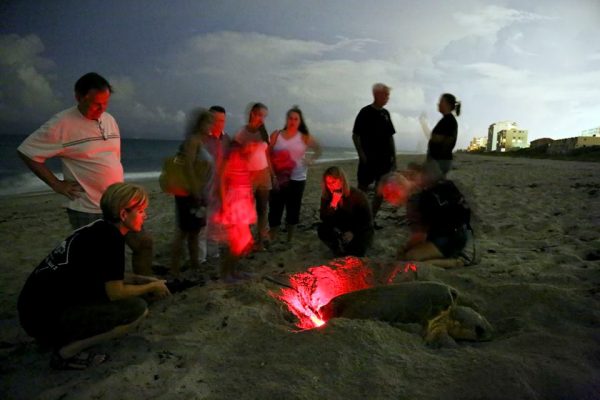It’s that time of the year again; nesting season is here in the state of Florida! The majority of nesting in Florida occurs between May 1st and October 31st. About 90% of all sea turtle nesting in the United States takes place on Florida’s beaches, which means it is critical that residents and visitors alike do their part to ensure that sea turtles have a safe and successful nesting season. By reading the tips below, you can do your part to make sure they’re made part of your beach routine!

Loggerhead returns to sea after nesting (Photo Credit: Blair Witherington)
Use sea turtle-friendly lights or no lights at all! In order to prevent nesting and hatchling turtles from wandering off track, your beachfront property should use sea turtle friendly lighting. You can also help by closing drapes and blinds, and shield or turn off outdoor lights that are visible on the beach. Sea turtle hatchlings can become easily disoriented by bright lights on the coast from hotels and beachfront properties. By following these steps, you can encourage females to nest and lead hatchlings in the right direction, the ocean!

Tracks from disoriented hatchlings. Their tracks should lead straight to the sea.
Knock down sandcastles and fill in holes! Although this is every kid’s nightmare, it’s important to knock your sandcastle over and flatten out the sand at the end of the day. Additionally, filling in all holes made in the sand can avoid the entrapment of hatchlings while on their way to the water. Even the nesting mothers can become stuck in these holes when crawling up the beach to nest. Furthermore, remove all beach accessories, such as tents, umbrellas, toys, and chairs. These can prevent obstacles for both the mother and the hatchlings.

An adult loggerhead fell into a large hole on the beach and had to be rescued by Beaches Sea Turtle Patrol
Avoid the attraction of unwanted pests. Raccoon, foxes, coyotes and other types of animals all have one thing in common: they love our leftovers. Raccoons destroy thousands of sea turtle eggs each year and are one of the greatest causes of sea turtle mortality on Florida’s beaches. Leaving food outside for neighborhood dogs and cats also attracts raccoons. You can help deter these animals from destroying sea turtle eggs by cleaning up food and additional trash after a day at the beach.
Program the phone number for your area’s wildlife stranding hotline into your phone so you’ll be prepared if you happen to encounter a dead, sick, stranded or injured sea turtle. It is also important to report any harassment of sea turtles or disturbance of nests. In Florida, you can call FWC Wildlife Alert Number at 1-888-404-3922 or visit their website. For other states, you can find a list of contact info here.

Don’t interfere with the nesting or hatching process. It’s important to allow hatchlings to crawl to the water on their own. Many scientists believe the journey from nest to water allows them to imprint on their own beach. Picking up hatchlings may interfere with this process. It is also illegal to touch sea turtles under both federal and state laws.
Don’t place beach furniture too close to a marked nest. If possible, place furniture at least 5 feet away. Furniture can mislead turtles during the hatching process and also entrap them. Also make sure to put away your beach furniture at the end of the day as they become a dangerous obstacle for a nesting turtles.

Loggerhead turtle stuck under a chair that was left on the beach. Photo via Anna Maria Island Turtle Watch
Don’t use fireworks on the beach. Although this can be tempting with 4th of July right around the corner, think about how the loud noises and bright lights can disturb nesting females. Instead, many local organizations hold inland fireworks displays for your enjoyment. Bonfires on the beach also pose a danger to sea turtles.
If you would like to watch a nesting turtle, join an organized sea turtle walk. In Florida and other states where sea turtles nest, turtle watches are conducted by trained and permitted individuals. The goal is to educate people about sea turtles through direct contact, without disturbing the turtles. Click here for more information about registering to join an STC Turtle Walk.

Photo courtesy Greg Lovett, Palm Beach Post (taken using long-exposure, no flash)